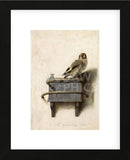© 2025 McGaw Graphics, Inc.
Product Detail
- Overall: 16" H x 13" W x 0.75" D
- Overall Product Weight: 2.5lb.
- Material: Glass
- High quality print on heavy paper
- Printed with vibrant, color-fast inks
- Framed in a contemporary style molding; available in black, gold, and white
- Sawtooth hanger
- Unmatted
About the Artist
Carel Pietersz. Fabritius was born in February 1622 in Middenbeemster, a village in the ten-year old Beemster polder in the Dutch Republic, and was baptized on 27 February of that year. He was the son of Pieter Carelsz., a painter and schoolteacher, and he had two younger brothers Barent and Johannes, who also became painters. Initially he worked as a carpenter (Latin: fabritius). In the early 1640s he studied at Rembrandt's studio in Amsterdam, along with his brother Barent. Of all Rembrandt's pupils, Fabritius was the only one to develop his own artistic style. A typical Rembrandt portrait would have a plain dark background with the subject defined by spotlighting. In contrast, Fabritius' portraits feature delicately lit subjects against light-coloured, textured backgrounds. Moving away from the Renaissance focus on iconography, Fabritius became interested in the technical aspects of painting. He used cool color harmonies to create shape in a luminous style of painting. Fabritius was also interested in complex spatial effects, as can be seen in the exaggerated perspective of A View of Delft, with a Musical Instrument Seller's Stall (1652). He also showed excellent control of a heavily loaded brush, as in The Goldfinch (1654). All these qualities appear in the work of Delft's most famous painters, Vermeer and de Hooch; it is likely that Fabritius was a strong influence on them. Fabritius died young, caught in the explosion of the Delft gunpowder magazine on October 12, 1654, which destroyed a quarter of the city, along with his studio and many of his paintings. Only about a dozen paintings have survived, four of which are in National collections in the United Kingdom.





